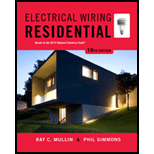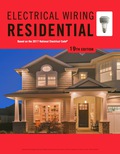
Electrical Wiring Residential
18th Edition
ISBN: 9781285170954
Author: Ray C. Mullin, Phil Simmons
Publisher: Cengage Learning
expand_more
expand_more
format_list_bulleted
Concept explainers
Textbook Question
Chapter 23.1, Problem 1R
- a. What is the allowance in watts made for electric heat in this residence? ________
- b. What is the value in amperes of this load? _______________________________
Expert Solution & Answer
Trending nowThis is a popular solution!

Students have asked these similar questions
12.43 For the circuit shown in Fig. P12.43, determine Vout (1)
given that R₁ = 1 kQ, R₂ = 4k, and C = 1 μF, and
(a) v(t)=2u(1) (V),
(b) s(t)=2 cos(10001) (V),
(c) vs(t) = 2e u(t) (V).
R1
Us(1)
+
R2
Dout(1)
Figure P12.43 Op-amp circuit for Problem 12.43.
12.41 The circuit shown in Fig. P12.41 was introduced in
Problem 5.68. Then, a time-domain solution was sought for
Dout, (1) and Dout₂ (1) for 10, given that v₁(1) = 10u(t) mV,
Vcc 10 V for both op amps, and the two capacitors had no
change prior to t = 0. Analyze the circuit and plot Dout, (t) and
Dout (1) using the Laplace transform technique.
4μF
5 μF
Οι 5 ΚΩ
Dout 1 MQ
Dout2
+
Vcc = 10 V
Vec = 10 V
Figure P12.41 Circuit for Problems 12.41 and 12.42.
12.38 If the circuit shown in Fig. P12.38(a) is excited by the
current waveform is(t) shown in Fig. P12.38(b), determine i(t)
for 1 > 0, given that R₁ = 102, R2 = 5 92, and C = 0.02 F.
is(t)
R₁
i(t)
R₂
is(t)
1.5 A
1.5A |
1 A
0.5 A-
M
0.5A-
(a) Circuit
www.
(b) Waveform
0 = 4 rad/s
t
Figure P12.38 Circuit for Problems 12.38 to 12.40.
Chapter 23 Solutions
Electrical Wiring Residential
Ch. 23.1 - a. What is the allowance in watts made for...Ch. 23.1 - What are some of the advantages of electric...Ch. 23.1 - List the different types of electric heating...Ch. 23.1 - There are two basic voltage classifications for...Ch. 23.1 - What device is required when the total connected...Ch. 23.1 - Prob. 6RCh. 23.1 - Prob. 7RCh. 23.1 - A certain type of control connects electric...Ch. 23.1 - What advantages does a 240-volt heating unit have...Ch. 23.1 - The white wire of a cable may be used to connect...
Ch. 23.1 - Receptacle outlets furnished as part of a...Ch. 23.1 - The branch circuit supplying a fixed electric...Ch. 23.1 - Prob. 13RCh. 23.1 - For ballpark calculations, the wattage output of a...Ch. 23.1 - A central electric furnace heating system is...Ch. 23.1 - What section of the Code provides the correct...Ch. 23.1 - Electric heating cable embedded in plaster, or...Ch. 23.2 - Prob. 1RCh. 23.2 - Prob. 2RCh. 23.2 - Prob. 3RCh. 23.2 - a. Must an air conditioner installed in a window...Ch. 23.2 - Prob. 5RCh. 23.2 - What is the Code requirement for receptacles...Ch. 23.2 - Prob. 7RCh. 23.2 - When the nameplate on an air-conditioning unit...Ch. 23.2 - Prob. 9RCh. 23.2 - Match the following terms with the statement that...Ch. 23.2 - The disconnect for an air conditioner or heat pump...
Knowledge Booster
Learn more about
Need a deep-dive on the concept behind this application? Look no further. Learn more about this topic, electrical-engineering and related others by exploring similar questions and additional content below.Similar questions
- EXERCISE 1: Consider the waveguide of Example Calculate the phase constant, phase velocity and wave impedance for TE10 and TM11 modes at the operating frequency of 15 GHz. = 192.4 . For Answer: For TE10, B = 615.6 rad/m, u = 1.531 × 108 m/s, TE 529.4 rad/m, u = 1.78 x 10 m/s, TM = 158.8 Q. TM11, B Example 1: A rectangular waveguide with dimensions a = 2.5 cm, b = 1 cm is to operate below 15.1 GHz. How many TE and TM modes can the waveguide transmit? if the guide is filled with a medium characterized by σ = 0, &=4&o Hr = 1° Calculate the cutoff frequencies of the modes.arrow_forwardlossles 016 X= x+jB α= 0 B=w/ME Up= E = Free s space Mo M, E.Er K = Em² Cos(ut-132) az 2 = √μ =377 √ 6 <20 lossy auto WE ليا + B = w√ Me [√ 1+ (e) + 1] 0 Sp = = Mr B2= 사용 -42 we 333 ov+ jut E=Eme Cos/wt-Bz) az Good Conductor X = B = √TPMN 11 42 6√70 7 20 WE E=Eml Gos(wt-Bz) azarrow_forwardmicro wave.arrow_forward
- micro wave.arrow_forwardDon't use ai to answer I will report you answer pleasearrow_forwardDraw the digital modulation outputs, ASK (Amplitude Shift Keying), FSK (Frequency Shift Keying) and PSK (Phase Shift Keying). For baseband and carrier frequency as shown BASESAND 0 CARRIER 101 wwwwwwwwwwwwwarrow_forward
- Don't use ai to answer I will report you answerarrow_forwardplease explain step by step how ti solve these problems and include good explanations. I am most confused with graphing. Thank you, I will give positive feedback. The rest of the questions to this problem are submitted as a new questions due to the multiple part limitarrow_forwardDon't use ai to answer I will report you answerarrow_forward
- This is the last two questions of a previous question I just sent. Please show step by step with clear explanations as to what to do for these questions. I am very confused. Thank you, I will give positive feedbackarrow_forwardNO AI WILL REJECT(using laplace table only)arrow_forwardNO AI WILL REJECT(using laplace table only)arrow_forward
arrow_back_ios
SEE MORE QUESTIONS
arrow_forward_ios
Recommended textbooks for you
 EBK ELECTRICAL WIRING RESIDENTIALElectrical EngineeringISBN:9781337516549Author:SimmonsPublisher:CENGAGE LEARNING - CONSIGNMENT
EBK ELECTRICAL WIRING RESIDENTIALElectrical EngineeringISBN:9781337516549Author:SimmonsPublisher:CENGAGE LEARNING - CONSIGNMENT

EBK ELECTRICAL WIRING RESIDENTIAL
Electrical Engineering
ISBN:9781337516549
Author:Simmons
Publisher:CENGAGE LEARNING - CONSIGNMENT
What is an electric furnace and how does it work?; Author: Fire & Ice Heating and Air Conditioning Inc;https://www.youtube.com/watch?v=wjAWecPGi0M;License: Standard Youtube License